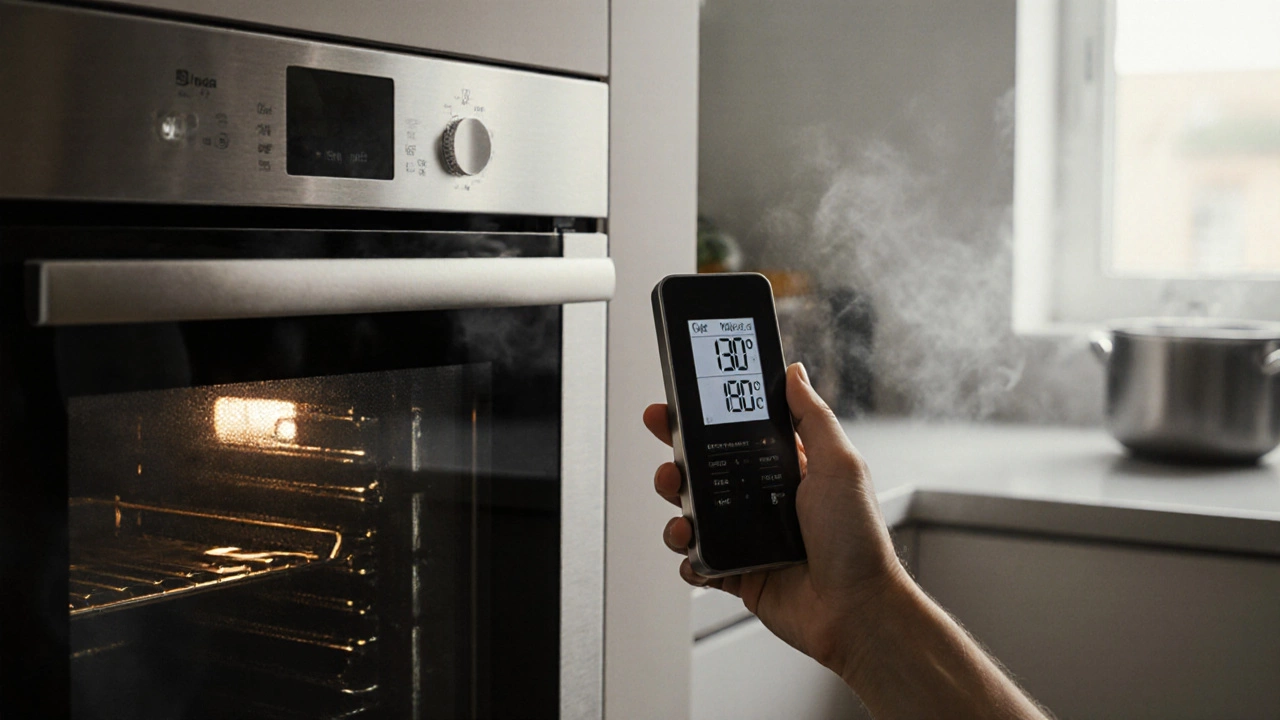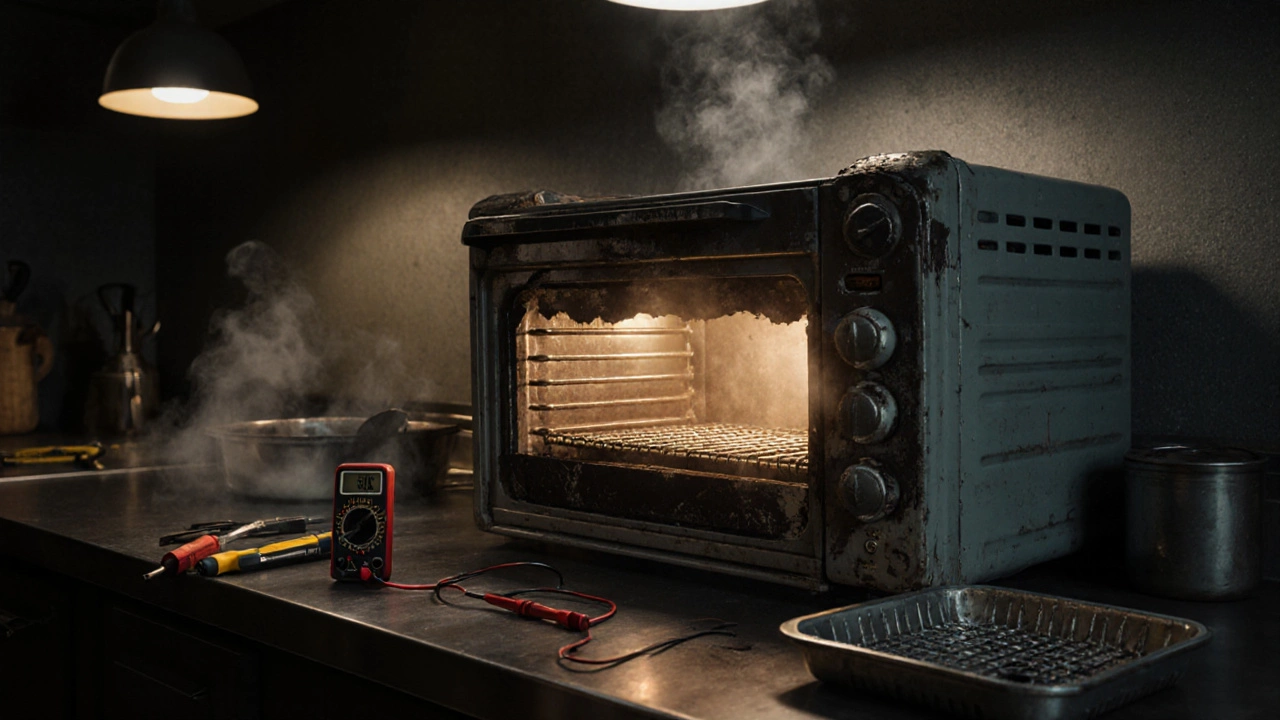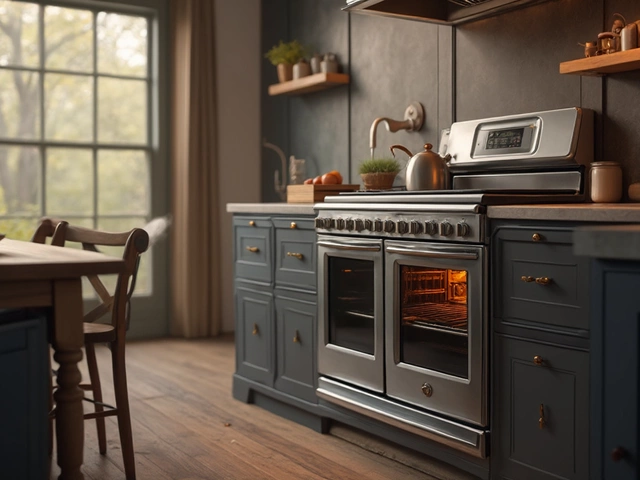If your electric oven isn’t heating up, you’re not alone. It’s one of the most common complaints we hear in Bristol, especially during the colder months. You turn the dial, wait for the beep, and… nothing. No warmth. No smell of baking. Just cold air. It’s frustrating, especially when you’ve got a roast in the pan and dinner’s due in 30 minutes. The good news? Most of the time, this isn’t a sign your oven is beyond repair. In fact, 8 out of 10 cases are caused by one of five simple issues.
The heating element is broken
The heating element is the most likely culprit. It’s the coil at the top or bottom of your oven that glows red when it’s working. If it’s broken, it won’t glow - even if the oven light turns on. A damaged element might look cracked, blistered, or have a gap in the wire. Sometimes, it’s not visible without pulling the oven out and removing the back panel.
Most electric ovens have two elements: one for baking (bottom) and one for grilling (top). If only the top element works, you might get broiling but no baking. If neither works, the problem is probably the main bake element. You can test it with a multimeter. Set it to ohms (Ω), disconnect the power, and touch the probes to the element’s terminals. If it reads infinite resistance or nothing at all, the element is dead. Replacing it costs between £40 and £80, and it’s a job you can do yourself if you’re comfortable with basic tools.
The thermostat is faulty
Your oven’s thermostat controls the temperature by turning the heating element on and off. If it’s stuck or misreading, your oven might think it’s already hot - even when it’s cold. This is why you sometimes hear the fan running but feel no heat.
Signs of a bad thermostat include inconsistent cooking times, food burning on the outside but raw inside, or the oven not reaching the set temperature. You can test it with a standalone oven thermometer. Place it in the center of the oven, set the temperature to 180°C, and wait 20 minutes. If the thermometer reads more than 15°C off, your thermostat is likely faulty. Replacement thermostats cost around £50 to £70. Some models are easy to swap; others require calibration by a technician.
The oven selector switch has failed
This is a hidden problem. The selector switch is the dial or button you use to choose between bake, broil, and convection. Over time, the internal contacts wear out. You might turn the knob to bake, but the switch isn’t sending power to the right element. It’s easy to mistake this for a broken element because the symptoms are identical.
To check it, turn the oven on to bake. Then, while it’s running, gently wiggle the selector knob. If the oven suddenly heats up, or if you hear a click and the element glows, the switch is loose or failing. You can test continuity with a multimeter by removing the control panel and checking the switch terminals. If there’s no connection when it should be closed, replace the switch. It’s a £30 part, but the job requires removing the control panel - which can be tricky on built-in ovens.

The thermal fuse has blown
The thermal fuse is a safety device that cuts power if the oven overheats. It’s usually located near the heating element or the vent system. If it blows - often because of a blocked vent, a failed thermostat, or a power surge - your oven won’t heat at all. Unlike a fuse in a plug, this one can’t be reset. You have to replace it.
How do you know if it’s blown? If your oven was working fine, then suddenly stopped heating with no warning, and you’ve already checked the element and thermostat, the thermal fuse is next on the list. It’s a small, cylindrical component with two wires. Test it with a multimeter. If it shows no continuity, it’s dead. Replacement fuses cost under £10. But here’s the catch: if you replace the fuse without fixing what caused it to blow, it’ll blow again. Check for blocked vents, dirty filters, or a stuck fan.
Power supply issues
Your oven runs on 240 volts, not the standard 120 volts like most plugs. That means it needs a dedicated circuit with a double-pole breaker. If one side of the breaker trips - which can happen without the whole circuit shutting off - your oven might still have power for the light and clock, but not for the heating elements.
Check your consumer unit. Look for a double-width breaker labeled “oven” or “cooker.” If it’s halfway between on and off, reset it. If it trips again right away, don’t keep resetting it. There’s a short circuit somewhere - probably in the wiring, element, or control board. If you’re not trained to handle live electrical panels, call an electrician. Trying to fix this yourself could be dangerous.
What to do if none of these fixes work
If you’ve checked the element, thermostat, selector switch, thermal fuse, and power supply - and your oven still doesn’t heat - the problem is likely the control board. This is the brain of your oven. It sends signals to all the parts. If it’s damaged by a power surge, moisture, or age, it won’t activate the heating elements.
Control boards are expensive. They cost between £120 and £250, depending on your oven model. Labour to replace one can add another £80 to £120. For ovens older than 10 years, it’s rarely worth the cost. You’ll spend more on repair than a new entry-level oven. But if your oven is relatively new and you love its features, replacing the board might be the right call.
Before you buy a new oven, make sure the old one isn’t just a simple fix. I’ve seen people replace perfectly good ovens because they thought the element was dead - only to find out the thermal fuse had blown. Always check the cheapest, easiest fixes first.
Quick checklist: What to test first
- Is the oven receiving power? Check the circuit breaker.
- Does the oven light work? If yes, power is getting to the unit.
- Can you see the heating element glowing? If not, test it with a multimeter.
- Does the oven reach temperature? Use a separate oven thermometer.
- Does the oven behave differently when you switch between bake and broil? If one works and the other doesn’t, the selector switch or element is likely the issue.
- Is there any burning smell or visible damage inside the oven?
If you’re unsure about using a multimeter or opening the oven panel, don’t force it. Electricity and appliances don’t mix with guesswork. A certified appliance technician can diagnose this in under 30 minutes.
When to replace instead of repair
Here’s a simple rule: if the repair cost is more than half the price of a new oven, walk away. A basic electric oven costs £300 to £500. If your repair bill hits £200+, it’s time to think about replacement. Also, if your oven is over 12 years old, parts are harder to find, and efficiency has dropped significantly. Newer models use 20% less energy and have better temperature control.
Look for ovens with a clear energy label (A+++ is best). Brands like Bosch, Neff, and Hotpoint have reliable heating systems and good customer support in the UK. Avoid no-name brands - they often cut corners on elements and thermostats.
Prevent future problems
Keep your oven clean. Grease buildup can cause overheating and trigger the thermal fuse. Wipe spills when the oven is cool. Don’t line the bottom with foil - it blocks airflow and can cause elements to overheat. Make sure the oven vents aren’t blocked by cabinets or clutter. And if you live in an area with frequent power surges, consider installing a surge protector for your kitchen appliances.
Most oven failures happen after 8-12 years. But with basic care, you can stretch that to 15. Regular maintenance saves money, time, and stress.
Why does my oven light work but the oven doesn’t heat?
The oven light runs on standard 240V power, but the heating elements need both live wires to function. If one side of the double-pole breaker has tripped, the light stays on but the elements don’t get full power. Check your consumer unit and reset the oven’s breaker. If it trips again, there’s likely a fault in the wiring or element.
Can a dirty oven stop it from heating?
Not directly, but heavy grease buildup can cause overheating. When grease catches fire or smokes, it triggers the thermal fuse as a safety measure. Once the fuse blows, the oven stops heating entirely. Regular cleaning prevents this. Also, blocked vents from debris can cause the oven to overheat and shut down.
How do I test my oven element without a multimeter?
You can’t reliably test an element without a multimeter. But you can do a visual check. Turn the oven on to 200°C and watch the element for 10 minutes. If it doesn’t glow red at all, it’s likely broken. If it glows unevenly - some parts red, others dark - it’s failing. This isn’t a perfect test, but it’s a good first step.
Is it safe to use an oven that doesn’t heat properly?
It’s not dangerous to use an oven that doesn’t heat - it just won’t cook food. But if you’re seeing sparks, smoke, or a burning smell, turn it off immediately. These are signs of a serious electrical fault. Don’t try to fix it yourself unless you’re qualified. Call a professional.
Why does my oven heat up slowly?
A slow-heating oven usually means one element is weak or the thermostat is inaccurate. If only one element is working (e.g., the broil element), baking will take much longer. Clean the element and test it. If it’s fine, the thermostat might be miscalibrated. Use a standalone oven thermometer to check the actual temperature versus the setting.




